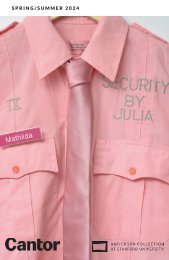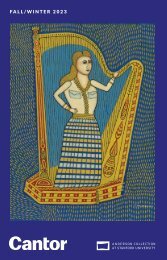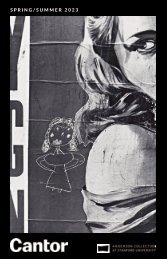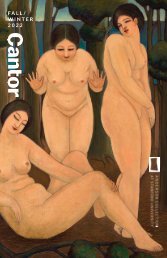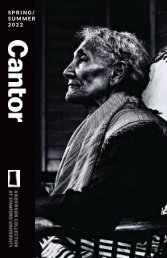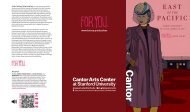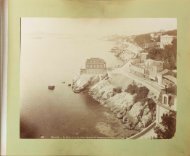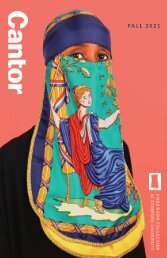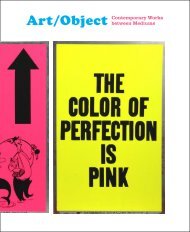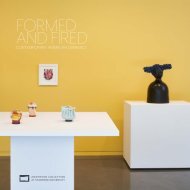Learning Guide | Artists & Anatomists
After the sixteenth century, European artists gained knowledge of human anatomy studying live models and attending anatomical demonstrations held at academies and studios—or sought out work with medical men with access to corpses. Whether created to represent an empirical or imagined encounter, these representations of the body often reveal society’s conflicted feelings about anatomical study being research toward a greater good, or a perverse and sacrilegious violation. Elizabeth Kathleen Mitchell, PhD Burton and Deedee McMurtry Curator, and Director of the Curatorial Fellowship Program
After the sixteenth century, European artists gained knowledge of human anatomy studying live models and attending anatomical demonstrations held at academies and studios—or sought out work with medical men with access to corpses. Whether created to represent an empirical or imagined encounter, these representations of the body often reveal society’s conflicted feelings about anatomical study being research toward a greater good, or a perverse and sacrilegious violation.
Elizabeth Kathleen Mitchell, PhD
Burton and Deedee McMurtry Curator, and Director of the Curatorial Fellowship Program
Create successful ePaper yourself
Turn your PDF publications into a flip-book with our unique Google optimized e-Paper software.
<strong>Artists</strong> &<br />
<strong>Anatomists</strong><br />
Elizabeth Kathleen Mitchell, PhD<br />
Burton and Deedee McMurtry Curator and Director of the Curatorial Fellowship Program<br />
■ ■ ■ ■ ■ ■ ■ ■ ■ ■ ■ ■ ■ ■ ■ ■ ■ ■ ■ ■ ■ ■ ■ ■<br />
Introduction<br />
After the sixteenth century, the processes by which European artists<br />
gained knowledge of human anatomy increasingly informed images<br />
ranging from the documentary to the fantastical. Instead of learning<br />
anatomy and proportion exclusively by copying old master works<br />
of art, artists sought new and direct opportunities to understand<br />
the mechanics of the body. They studied live models and attended<br />
anatomical demonstrations held at academies and studios—or sought<br />
out work with medical men with access to corpses. <strong>Anatomists</strong> also<br />
hired draftsmen and printmakers to create visual records of their<br />
research, an experience offering exceptional access and insight.<br />
Whether created to represent an empirical or imagined encounter,<br />
these representations of the body often reveal society’s conflicted<br />
feelings about anatomical study being research toward a greater<br />
good, or a perverse and sacrilegious violation.
■ ■ ■ 1. Jan Stephan van Calcar’s woodcut title page to<br />
the 1543 text The Epitome (Of Human Corporal Anatomy)<br />
by physician and anatomist Andreas Vesalius (Flanders,<br />
1514–1564) depicts students and onlookers gathered around<br />
Vesalius while he teaches from a female corpse. Meant to<br />
evoke the anatomy theater at the University of Padua where<br />
Vesalius was a professor, the image blends fact with dramatic<br />
flourishes of fiction. It presents an idealized imagining of<br />
Vesalius directing the empirical study of a body in a space that<br />
resembles a church or theatrical stage. A skeleton holding an<br />
instructor’s staff is seated on a railing just above the corpse,<br />
as if to preside over the lesson, and above it hovers a placard<br />
with the book’s title.<br />
1<br />
■ ■ ■ 2. Giorgio Ghisi’s image of resurrection is populated<br />
with animated skeletons and bodies with flesh, all in different<br />
states of completeness. These may have been drawn from<br />
anatomical specimens or inspired by the animated skeletons<br />
and bodies in the landmark anatomical atlas that had been<br />
published in 1543 by Andreas Vesalius (Flanders, 1514–1564).<br />
Ghisi worked in Rome in the 1540s, at which time he studied<br />
monuments from antiquity and may have studied with painter<br />
Giulio Romano (Italy, 1499–1546).<br />
2<br />
1. Jan Steven van Calcar, Italy, b. Germany, c. 1499–c. 1546. Title Page to The Epitome (Of Human Corporal Anatomy) / Epitome, Von des Menschen Cörpers Anatomey, 1543. Woodcut. 17 x 10-1/4 in.<br />
(sheet) 43.2 x 24 cm (sheet). Robert E. and Mary B. P. Gross Fund, 2012.591.a-b<br />
2. Giorgio Ghisi, Italy, 1520–1582. The Vision of Ezekiel, 1554. Engraving. 16 1/8 x 26 7/8 in 41 x 68.3 cm. Lent by Kirk Edward Long, L.15.352.2007<br />
2
3<br />
■ ■ ■ 3. This print by William Hogarth also was inspired in part by<br />
the title page image to the 1543 anatomical text by Andreas Vesalius<br />
(Flanders, 1514–1564) in the Cantor collection. It presents the<br />
end of character Tom Nero, who had been executed by hanging for<br />
murdering his pregnant girlfriend. England’s Murder Act of 1751<br />
mandated that criminals executed for murder could not be buried.<br />
Furthermore, anatomists could take any bodies not claimed by family.<br />
The print’s title suggests that the dissection, witnessed by students<br />
and indifferent onlookers who paid admission, is the criminal’s true<br />
punishment. Hogarth attended dissections and, when he ran a<br />
drawings studio, engaged surgeon William Hunter (1718–1783) to<br />
instruct his students.<br />
4<br />
■ ■ ■ 4. Samuel Ireland’s unflattering satire may depict the Scottish<br />
brothers John (1728–1793) and William Hunter (1718–1783), who<br />
counted among the most influential surgeons and anatomists of their<br />
day. The image expresses eighteenth-century Britain’s conflicted<br />
ideas about anatomical study. Its physicians enjoyed an international<br />
reputation for pioneering research based on the latest philosophical<br />
approaches and technologies informed by empirical study. At the<br />
same time, public opinion of anatomists was tainted by associations<br />
with grave-robbing, which provided fodder for satirists.<br />
5<br />
■ ■ ■ 5. In the late 1960s, African American painter Jacob Lawrence<br />
generated a series of drawings reacting the work of anatomist<br />
Andreas Vesalius (Flanders, 1514–1564). The drawings depict the<br />
raw architecture of man, here surrounded with representations<br />
of construction work, including saws, hammers, chisels, awls,<br />
nails, and a plumb line that dangles from the flayed man’s hands.<br />
As with Lawrence’s many images of builders, the tools reference<br />
the centuries of unacknowledged contribution made by Africans<br />
and Black Americans labor to the industry and infrastructure in<br />
the United States. But here, the body is stripped of its skin—and<br />
its outward racial identity—to reveal the interplay of muscles and<br />
tendons; this imagery expresses broader ideas about what, literally,<br />
makes the man.<br />
3. William Hogarth England, 1697–1764. The Reward of Cruelty, 1751. Etching with engraving. 50.6 x 42.3 cm<br />
(sheet) 19-15/16 x 16-5/8 in. (sheet). Gift of H. E. Pearson, 1989.126<br />
4. Samuel Ireland, England, c. 1760–1800. Doctors Dissecting, 1785. Etching. 9-7/8 x 11-15/16 in. 25.1 x 30.3 cm.<br />
Committee for Art Acquisitions Fund, 1986.23<br />
5. Jacob Lawrence, U.S.A., 1917–2000. Human Figure after Vesalius, 1968. Graphite on paper. 23-7/8 x 18 in. 60.6<br />
x 45.7 cm. Gift of Dr. Herbert J. Kayden and Family in memory of Dr. Gabrielle H. Reem, 2013.101<br />
3
6<br />
■ ■ ■ 6. Cornelis Cort engraved this image after a drawing by Stradanus<br />
(Flanders, 1523–1605), a member of the Accademia del Disegno in<br />
Florence, which had been founded in 1563. The image represents the<br />
experience of formal art instruction by depicting students practicing<br />
painting, sculpture, engraving, architectural design, and drawing in<br />
an imaginary gallery space. In the left foreground, students draw<br />
directly from a skeleton. A man wearing spectacles raises a knife<br />
to a suspended corpse in order to remove the skin and reveal the<br />
muscles. This prominent depiction of anatomical study emphasizes the<br />
importance given to direct study of the body.<br />
■ ■ ■ 7. By the sixteenth century, Padua was Europe’s center for<br />
anatomical study. In addition, Italian artists were known for dissecting<br />
corpses on their own in order to study them closely and, ultimately, to<br />
better depict bodies in history paintings. In Pietro Francesco Alberti’s<br />
imagining of an art academy, students draw from a skeleton and, in<br />
the background at right, men gather around a body being opened at<br />
the chest. A painting of the Crucifixion hangs above the anatomization<br />
table. The arms of the corpse extend in a pose similar to that of Christ,<br />
and the male figures in the painting seem to react to both.<br />
7<br />
8<br />
■ ■ ■ 8. An instructor and three youths stand at the bases<br />
of elevated statues of Hercules, Apollo, and Venus in the<br />
upper left quarter of this imaginative depiction of an art<br />
academy. The instructor directs the students toward a<br />
cast of an ecorché, a corpse with the skin removed, rather<br />
than the classical sculptures. The teacher’s actions stress<br />
the Enlightenment belief that the artist must study nature<br />
directly in addition to the more traditional and stylized<br />
interpretations of the body.<br />
6. Cornelis Cort, the Netherlands, 1533–before 1578. The Practice of the Visual Arts, 1578.<br />
Engraving. 17 3/16 in. x 11 3/4 in. (plate) 18 x 12 5/8 in. (sheet) 43.7 x 29.9 cm. Lent by Kirk<br />
Edward Long, L.15.234.2007<br />
7. Pier Francesco Alberti, Italy, 1584–1638. The Academy of Painters (Academia d’Pitori), c. 1610.<br />
Etching. 20-3/4 x 16-1/8 in. 52.7 x 41 cm. Committee for Art Acquisitions Fund, 1975.4<br />
8. Nicolas Dorigny, France, 1658–1746. To Youthful Students of Design, 1728. Engraving. 16-5/16<br />
x 11-1/4 in. 41.5 x 28.5 cm. Robert E. and Mary B. P. Gross Fund, 2007.3<br />
4
9 10 11<br />
■ ■ ■ 9. Juan Conchillos Falcó trained at the Royal Academy in Valencia and worked as a court painter in<br />
Madrid. Now he is remembered primarily for his fine draftsmanship. The male figure is naturalistic and closely<br />
observed; most likely he was drawn by lamplight, which accounts for the dramatic, flickering highlights<br />
rendered in white chalk. Vigorously drawn lines in black chalk articulate the shadowy contours of the model’s<br />
musculature, particularly in his legs, and his dynamic pose.<br />
■ ■ ■ 10. Professional and amateur artists consulted manuals when learning to draw, and Denis Diderot’s<br />
(France, 1713–1784) Encyclopédie featured a significant explanation of the art and science that informs<br />
drawing. This illustration presents the musculature of the lower leg and a guide to the proportions of the feet,<br />
which speaks to the Enlightenmen impulse<br />
9<br />
to observe, document, and disseminate standards for measuring<br />
and interpreting nature.<br />
■ ■ ■ 11. Printmaker Beth Van Hoesen attended Stanford University in the mid-1940s and produced this<br />
drawing while studying with painter and muralist Victor Arnautoff (1890–1979), who taught from 1938<br />
to 1962. By assigning students to draw a full-length study of a skeleton, Arnautoff pushed them to closely<br />
observe and develop familiarity with the essential structure and proportions of the body. Van Hoesen<br />
articulated physical mass and shadow by applying ink washes to represent the curves and hollows of the<br />
bones. She went well beyond the assignment by implying movement and sassy individuality through the<br />
skeleton’s jaunty pose and direct engagement of the viewer.<br />
9. Juan Conchillos Falcó, Spain, 1641–1711. Male Nude, 1702. Charcoal with blue and white chalk on paper. 16-5/16 x 11-1/4 in. 41.5 x 28.5 cm. Mortimer C. Leventritt Fund, 1976.95<br />
10. Robert Bénard, France, b. 1734. Drawing, Legs and Feet. (Dessein, Jambes et Pieds.), 1762–1777. Engraving. Gift of Dr. and Mrs. Jud R. Scholtz, 1978.118.19<br />
11. Beth Van Hoesen, U.S.A., 1926–2010. Stanford (Arnautoff Class), 1945. Graphite and ink on paper. 29-3/4 x 19-1/4 in. 75.6 x 48.9 cm. Gift of the Estate of Beth Van Hoesen,<br />
2011.62<br />
5



